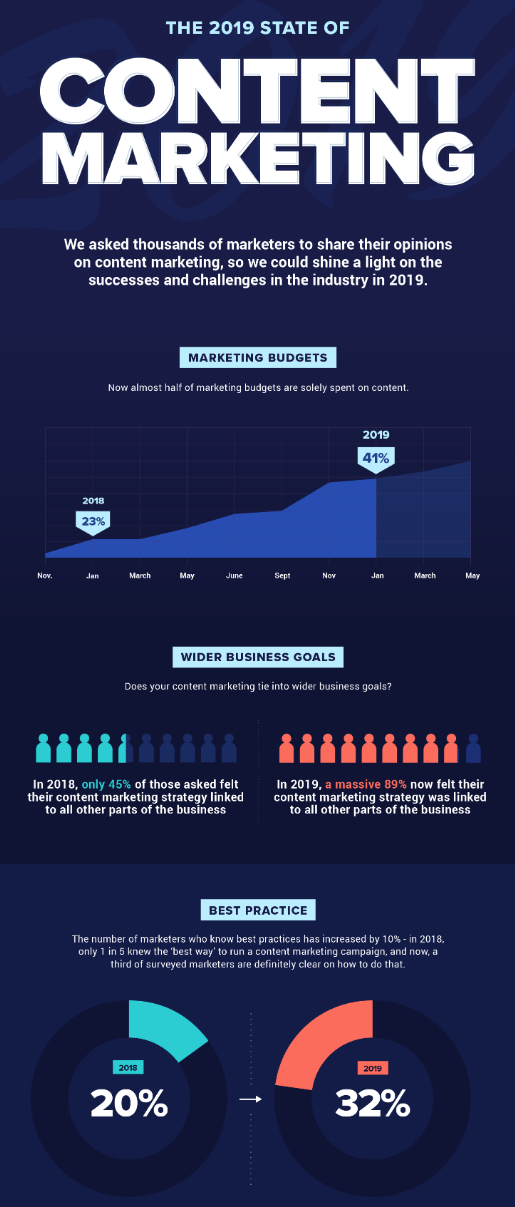 Doing your own B2B research can help you to demonstrate thought-leadership and position your company as an expert in your industry.
Doing your own B2B research can help you to demonstrate thought-leadership and position your company as an expert in your industry.
But research projects aren’t turned around overnight. Research can be a big investment, and to make the most of that investment you should be thinking about how you can create multiple pieces of content from your research.
Some people prefer visual infographics over text statistics.
Some choose podcasts over written reports.
Repurposing your research for different formats means extending its lifespan as well as your reach, and as a result, creating more opportunities to convert prospects into leads.
The good news is that your research findings can be packaged up in so many different ways.Of course, the first thing you want to do is create a research report that details all your findings. This can serve as a gated content offer to prompt conversions, much like an eBook or white paper typically would.
But you don’t only want to share a PDF that people can download. Here's how you can scale your research report into a whole library of content that will help you attract more interest and generate more leads.
Create a series of blog posts offering a deep dive into your research
Your research should give you lots of material for blog posts.
Take each of the key findings and write individual blog posts discussing what they each mean for your buyers and your industry.
Say there are 10 key points or takeaways your research highlights, then you’ve potentially got a series of ten separate blog posts where you can offer a deep dive into the results.
When writing your blogs, use headline statistics to frame your topic at the start of the post. Use them in your accompanied social messaging too so you draw readers' attention.
Then the important bit - offer the full report as a call-to-action (CTA) at the bottom of your blog post. The goal is to have whet their appetite enough to encourage them to download the report in exchange for a few details.
Present the results as an infographic
Make your research instantly more impactful and digestible with an infographic.
Sometimes, you don’t want to (or don't have time to) read a full report or a blog post, or even watch a video.
But, you might just divulge in a quick infographic.
An infographic can also act as a teaser to encourage people to download the full report. By adding it to a landing page, for example, you give people a preview that convinces them the report is worth downloading.
Infographics are highly shareable and great for social media, providing reach to a wider audience if a potential buyer then shares it on their Twitter or LinkedIn feed. In fact, infographics are shared and liked three times more often than other content formats.
HubSpot recently shared an infographic to present the findings of this years’ State of Content Marketing Survey. Below is just a snippet.

Use videos to engage people with your research
When it comes to using video to share your research findings, the opportunities are endless. Create a short video, up to 3 minutes long, highlighting key findings for use as a teaser on social media, your website, or a landing page. Or create a longer video telling the full research story that people can download.
For videos with no text, make sure to add visual narration in the form of subtitles or captions, especially if you’re going to share them on your social channels.
Below is an example of an animated video that HubSpot created to share insights from their State of Inbound Survey in 2016.
Check out this next example too, from the Content Marketing Institute (CMI). It features a number of different people in the industry discussing some of the key findings from the CMI’s latest research report.
Discuss the results in a podcast
Podcasts have soared in popularity over the last few years. For B2B marketers, they present yet another opportunity outside of written content to connect with prospects and customers.
Creating a podcast from your research can be pretty straightforward, as long as you have the basic equipment required to record it.
All you need to do is get a couple of you in a room talking openly about the research, drawing on interesting findings and discussing what you think it all means for your audience and your industry. Perhaps pull in an expert from a relevant part of your business that could offer an interesting take on the findings. Then offer the podcast as download, perhaps at the end of a blog post or infographic, in exchange for a few details.
As an example, check out this podcast episode from Joe Pulizzi and Robert Rose, where they discuss and debate the findings of a research study on marketing spending.
Here’s another interesting example from Research Podcasts, who created a series of podcasts interviewing the authors of a report outlining findings from the Millennium Cohort Study, which tracked the lives of nearly 20,000 children born in the UK in the year 2000.
Create a webinar event around your research
Webinars are interactive, engaging, and can help create a sense of event around your research. Set up a webinar to talk listeners through your research results step by step. You could also identify a problem or opportunity that the research highlights and set up a webinar where experts within your company offer advice on the topic.
Webinars can also be repurposed for on-demand access, creating an evergreen asset that will keep on generating leads.
Content saturation is a challenge that every business is facing. To stand out from the crowd, you need content that can create a real impact. And original research, with your company’s name on it, has the power to do that.
But be sure to make the most of your investment by repurposing your research into multiple pieces of compelling content. In doing so, you'll have more opportunities to build trust and credibility with your prospects - and generate more leads.


